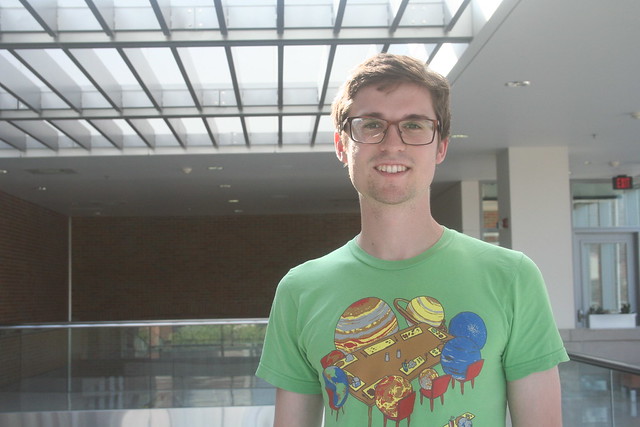A “Thermal” Summer: Research in Emitters Develops Student’s Interest in Academia
Travis Hamilton, a senior in electrical engineering, stayed on campus over the summer working with a research team. It wasn’t just busy work for him. “I learned a lot, and was given independent study. I worked on series of programs that simulate thermal emission,” he said
Professor Daniel Wasserman, Travis’ research leader and assistant professor, concentrates his work on lasers, microelectronics, and photonics. Basically, the research team is working on accommodating increasingly nanoscale systems with large-scale systems. An example would be creating a nano laser that can emit light at a wavelength larger than the actual nano laser.
Travis’ chosen focus has been in micro and nanotechnology. “They are broad fields within themselves, so I’m still getting my feet wet,” he said.

During his research, Travis had a post-doctorate or graduate student to bounce ideas off when there were challenges in his work. Prof. Wasserman would sit down every week with his team to talk and troubleshoot, and “it was a collaborative effort, but in the end you were responsible for your own project,” said Travis.
His favorite part of the internship was being exposed to the research process as an undergraduate. It was his first time to get to work with a professor one-on-one. “You can get that in a smaller class, but in research, the leader is really devoted to seeing your project fulfilled,” said Travis.
A “Micro” World
Travis actually met Prof. Wasserman through the electrical engineering program. He advised Travis on his academic schedule. “I told Dr. Wasserman upon transferring to Illinois that I wanted to do research in electromagnetics and optics. He suggested I come back to him once I had done a course on these topics,” said Travis.
But he was able to apply his skills sooner than he thought. “After talking with him a little later, he offered me a position in his lab over the summer,” said Travis
Classroom to the Real-World
Travis’ favorite part about his research was when he discovered the utility of Fourier Optics, a topic he had already learned in ECE 210 and MATH 286. “Without learning the concepts beforehand, I would’ve never been able to apply those ideas to optics,” he said.
A great deal of his research was done on Matlab, a program for numerical computation, visualization, and programming. On Matlab, he would perform simulations of distinctly patterned thermal emitters but it took hours for them to run on the computer. A Ph.D student shared his thesis paper with Travis and it described a better process. With information from the thesis and books from the library, Travis implemented the model in his code which cut down on the overall run time and provided more accurate results.

Above all Travis sees that his research experience has paid-off in the classroom. He appreciates the need for theoretical and experimental results and their complementary attributes in research.“I also feel motivated to pick classes with more purpose than I had in the past,” he said.
Ideally he’d love to work in academia and the more he talks to graduate students and professors, he feels, “it’s like being a football star,” in the world of science.
Advice on Summer Activities for Future Engineering Students
Travis advises to make sure you enjoy what you study.
“Don’t be shy of venturing off into your own interests. Don’t be shy of asking a professor a question. Pick up a book from the library, because not all of your interests will be fulfilled from what you learn in class.”
Travis also said to study in Everitt Lab. “You can get these classrooms all to yourself, if you go there around 6-7:30 p.m. There are these huge chalkboards, and who doesn’t love writing calculations on a chalkboard all to yourself. It’s in all the movies. It’s really handy if you have long homework assignments and it’s nice and quiet,” he said.
Comments - No Responses to “A “Thermal” Summer: Research in Emitters Develops Student’s Interest in Academia”
Sorry but comments are closed at this time.